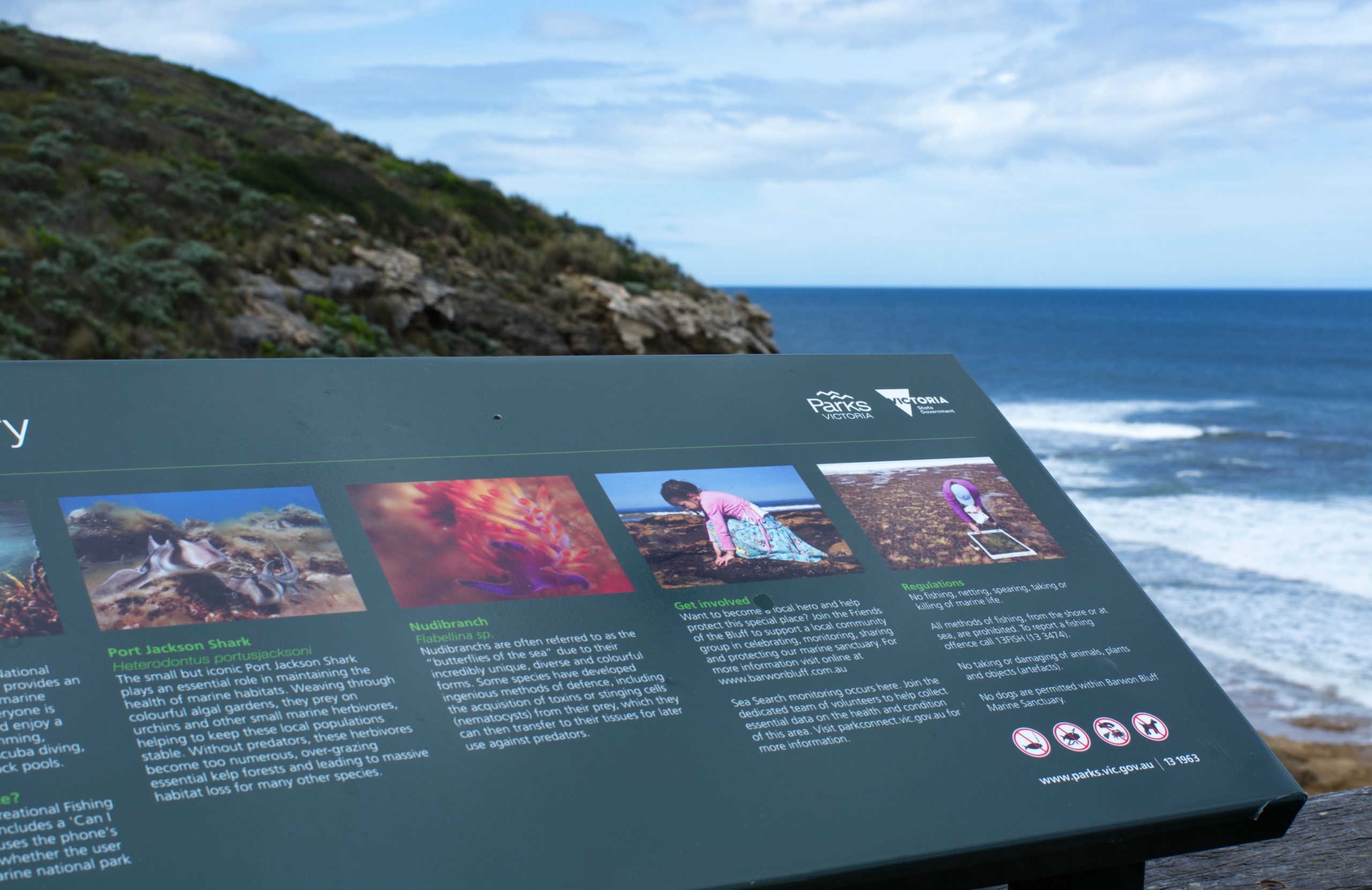
Barwon Bluff Marine Sanctuary
Barwon Bluff Marine Sanctuary is one of 11 Marine Sanctuaries and 13 Marine National Parks across Victoria that form a system of highly protected areas of the sea. These reserves complement our National Park system on land and provide protection for Victoria’s rich marine and coastal diversity of habitats and species.
Barwon Bluff Marine Sanctuary covers 17 hectares and is located at the mouth of the Barwon River in Barwon Heads, about 20 kilometers to the west of the entrance to Port Phillip.
Both sandstone and basalt intertidal and shallow subtidal reefs within the Marine Sanctuary provide habitat for a diverse range of marine flora and fauna and offshore support extensive kelp forests.
The Marine Sanctuary is a popular area for activities including walking, exploring local marine life, swimming, snorkelling, and diving. The rock platforms are home to an abundance of life while the waters provide stunning underwater vistas amongst the rich kelp forests.
The Bluff is a significant place for local Wadawurrung people who have visited the area as an important summer camping ground for many thousands of years. With a combination of sea, rock platforms, the river, and extensive wetlands to the north, the area provided a wide diversity of food sources and today has many reminders of this rich history including shell middens, campsites, and tools.
Due to the wide diversity of habitats within a small area Barwon Bluff Marine Sanctuary has enormous importance for students and teachers wanting to learn about Victoria’s marine and coastal environments.
For the protection of the marine environment, a number of activities are prohibited within the boundaries of Victoria’s marine national parks and marine sanctuaries. No fishing, netting, spearing, taking or killing of marine life is permitted and all methods of fishing, from the shore or the sea, are prohibited.
The Barwon Bluff Marine Sanctuary is a highly protected area reserved under the National Parks Act and all animals, plants, and artifacts within it are protected by law.
All objects (artefacts), animals, plants, and the seabed are totally protected in the Marine Sanctuary. There are significant penalties for fishing or collecting within the park.
Yellow triangles mark the edges of the Marine Sanctuary on land while bollards and signs remind visitors of the the no-take rules that apply.
If you see someone fishing or removing animals or plants from the Barwon Bluff Marine Sanctuary please report this on 13 FISH.
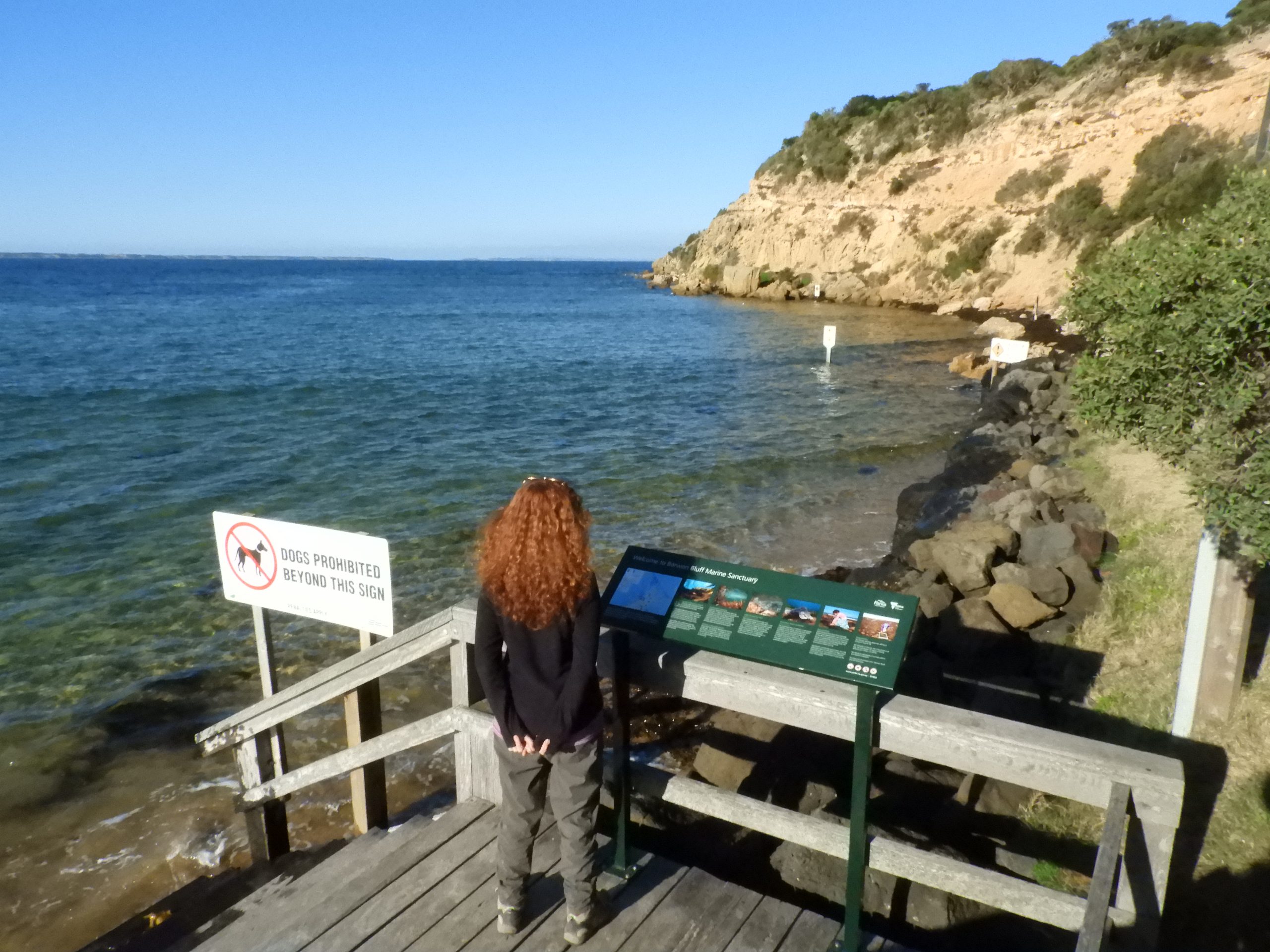
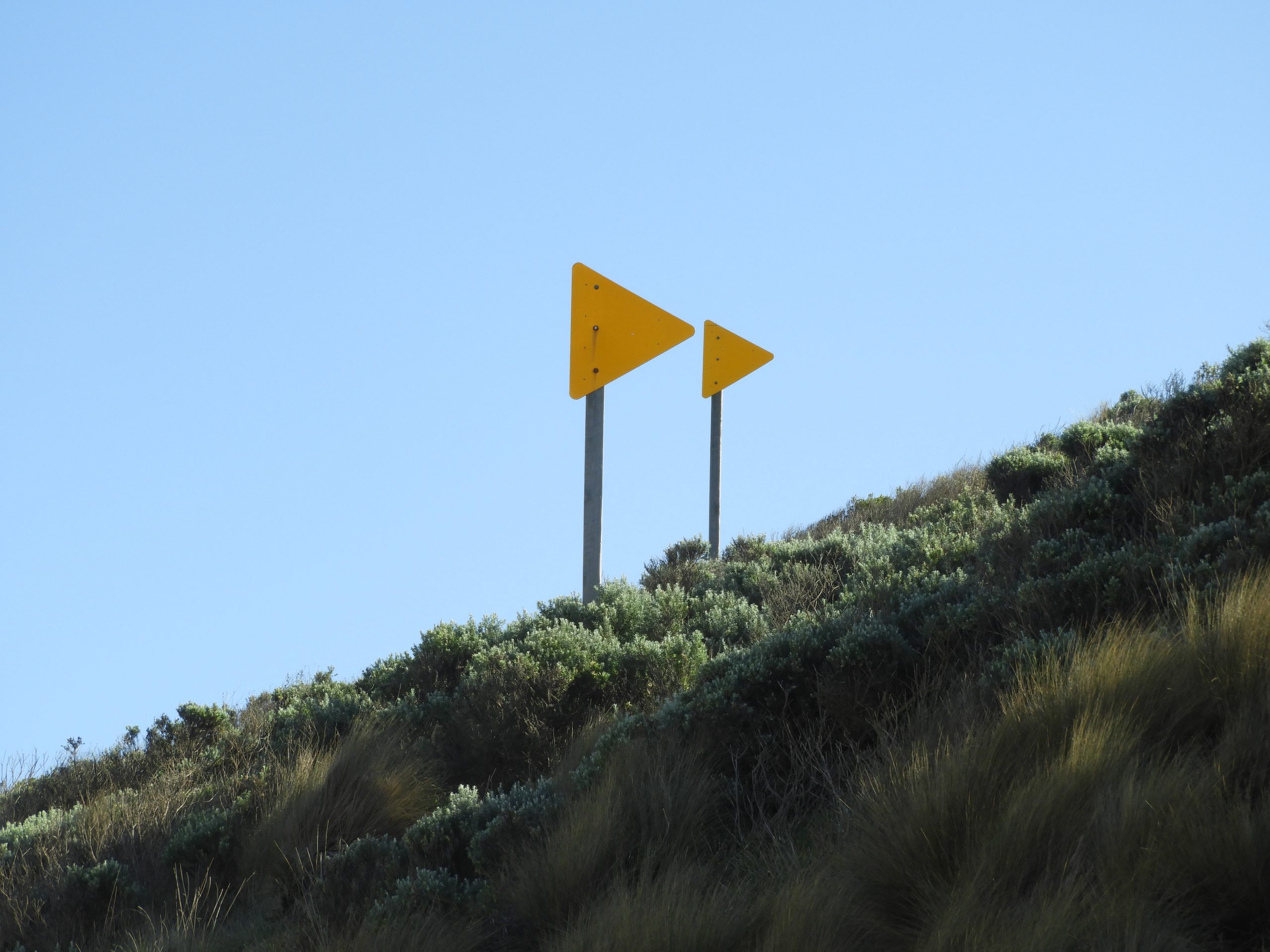
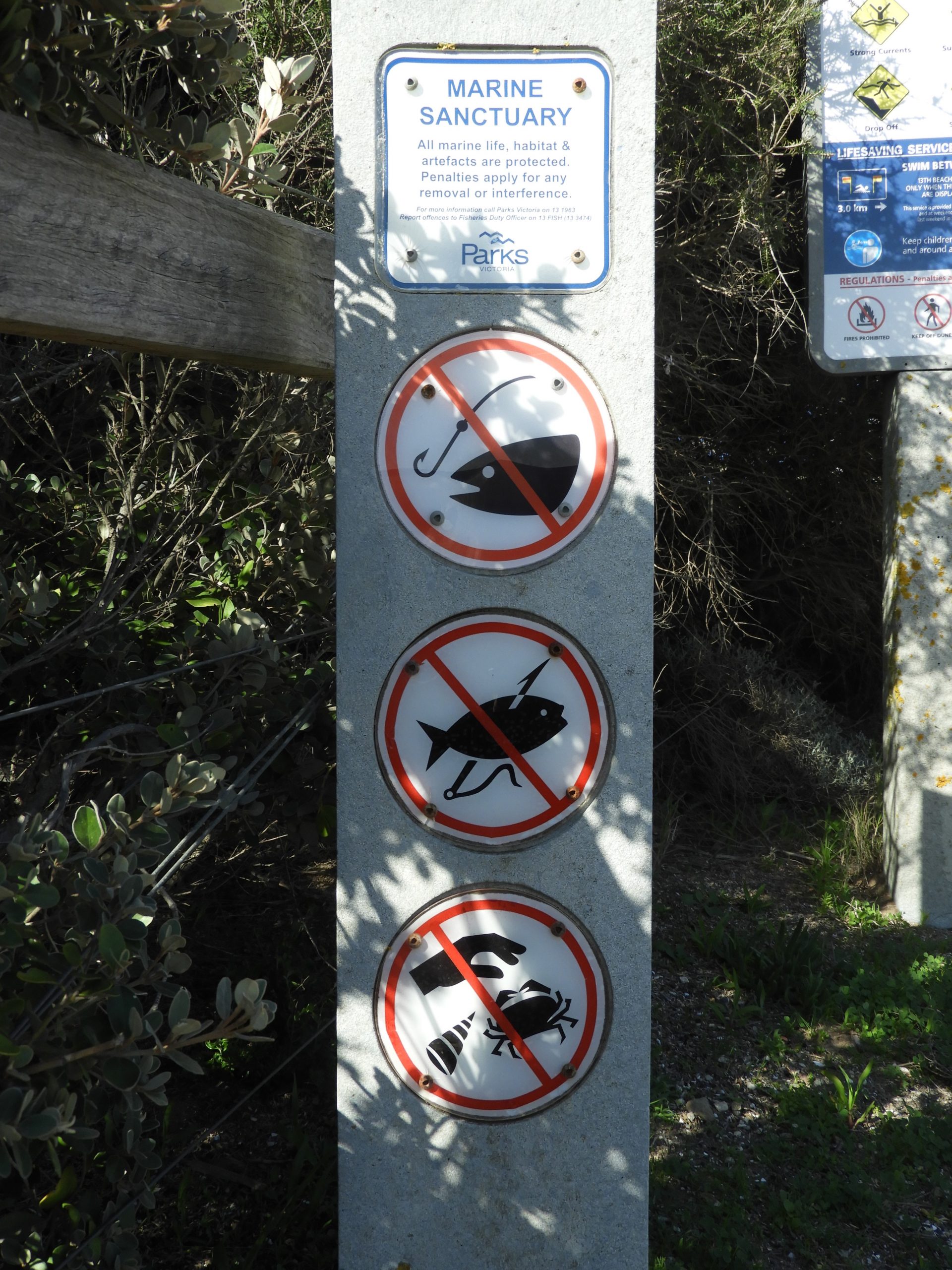
Can I Fish Here?
Fishers wanting to know the boundaries of the Barwon Bluff Marine Sanctuary, and other marine protected areas in Victoria, can also use the ‘Can I Fish Here?’ tool that is part of the Victorian Recreational Fishing Guide app. The app uses the devices GPS to locate the users in relation to the boundary and provides messages to let them know if they are in, near, or outside the park.
Download the app before going fishing using the QR code below.
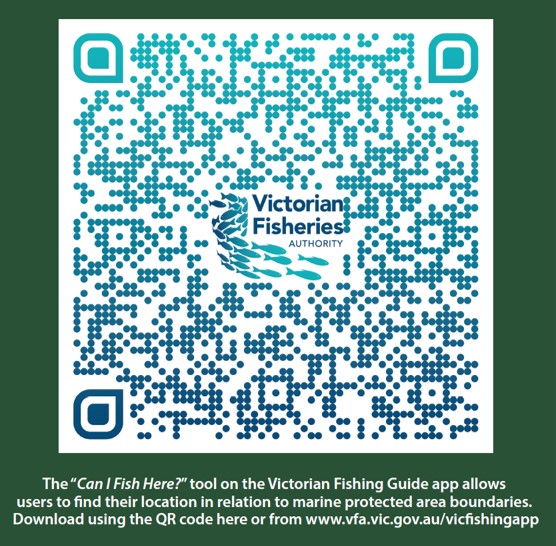
Facts About The Barwon Bluff
- The eastern half of the reef is basalt, formed from lava flow, and is exposed to the flow of the river. The western side is old sandstone and influenced by ocean swell. On the outer edges of the reef are the wrecks of 2 ships.
- The variation in conditions across the reef results in the presence of a huge diversity of plants and animals.
- Visitors can see anything from feather stars and barnacles to rock lobsters, rays and schools of fish. Bull Kelp, sandstone arches and sponge gardens create a fascinating and complex underwater world.
- We acknowledge the Aboriginal Traditional Owners of Victoria – including its parks and reserves. Indigenous tradition indicates that the sanctuary is part of Country of the Wadawurrung.
- Close to the township of Barwon Heads, the sanctuary extends 400 metres to the east and south of the headland. It is accessible from the shore through the Barwon Heads township or from ‘the Bluff’ via stairways.
- Friends of the Bluff undertake regular dives and walks to monitor our local marine environment and develop activities that raise the awareness of our diverse and remarkable coastal environment.
Physical Parameters and Processes
Waters to the east of Point Flinders are relatively calm, influenced predominantly by tidal currents and the flow of water from Barwon River. West of Point Flinders the intertidal platforms and beach are exposed to persistent high-energy south-westerly swells in Bass Strait.
Wind and wave action influence the beaches, affecting grain size, deposition and erosion. Natural hydrodynamic events such as storm surges displace seaweed and kelp communities, erode beaches and deposit sand over the reefs.
Surface water temperatures vary between an average 17.5°C in the summer and 13.5°C in the winter. Tidal variation is 2.1 metres for spring tides and 0.7 metres for neap tides.
The Barwon Bluff is geologically significant in Victoria as a coastal bluff comprised of Pleistocene dune calcarenite with interbedded palaeosoils, overlaying a basalt base.
The volcanic basalt that forms the reefs on the eastern side of the Bluff comes from nearby Mount Duneed which last erupted around 2 million years ago.
The Bluff itself was largely formed from wind blown sand and shell fragments during periods when sea levels were much lower than today. Over time the sand grains have been weakly cemented together by calcium carbonates derived from shells that have dissolved in rainwater. The action of the sea has eroded the southern section of the Bluff and created the rock platforms and cliffs we see today.
Marine Habitat Distribution and Ecological Communities
The main habitats protected by the sanctuary include intertidal and subtidal soft sediment, intertidal and subtidal reefs, and the water column.
The intertidal calcarenite and basalt reef is home to a variety of marine plants. The brown algae Neptune’s Necklace (Hormosira banksii) is a key habitat forming plant on these intertidal reefs. Other brown algae such as Cystophora retorta and Cystophora retroflexa are largely found very low on the shore or in rock pools. The seagrass Amphibolis antarctica also be found in rock pools.
Large patches of the Red Turf Algae (Capreolia implexa) can have very high cover on the intertidal reef. This alga can form a matrix with the Little Horse Mussel (Limnoperna pulex), which occurs in low abundance on the reef. Other aggregating invertebrates found at in the sanctuary include the Six-plated Barnacle (Chthamalus antennatus).
The sanctuary is home to more than 35 species of intertidal invertebrates including anemones that are common in rock pools, molluscs, seastars and shore crabs. The ascidian Pyura stolonifera is also present on the lowest edge of the intertidal reef.
Common fish on the Barwon Heads intertidal platform (found in rock pools) are the Tasmanian Blenny (Parablennius tasmanianus) and the Southern Crested Weedfish (Cristiceps australis).
The shallow (mostly 5 metres) subtidal rocky reefs in the sanctuary include areas of low profile reef close to sand patches which are generally dominated by mixed brown algae. In the west and away from the sand patches, the reef becomes dominated by the brown alga Crayweed (Phyllospora comosa).
On the seaward edge of the intertidal platform Bull Kelp (Durvillaea potatorum) forms a narrow band approximately 10 metres to 15 metres wide. Beds of Giant Kelp were found in the southern corner of the sanctuary.
A variety of invertebrates are found on subtidal reefs including molluscs (e.g., Black Lip Abalone (Haliotis rubra), Warrener (Turbo undulatus), Elephant Snail (Scutus antipodes) and Cart-rut Shell (Dicathais orbita). Also present are ascidians and crustaceans (e.g., Red Notched Crab (Plagusia chabrus) and the Southern Rocklobster (Jasus edwardsii).
At the eastern tip of the sanctuary filter-feeding invertebrates such as feather-stars and sponges are common due to the fast currents. Sea slugs (Opisthobranchs) can also be found on the reef sides.
Common fish on the subtidal reefs include the Blue-throated Wrasse (Notolabrus tetricus), Herring Cale (Odax cyanomelas), Victorian Scalyfin (Parma victoriae), Silver Sweep (Scorpis lineolata), Magpie Perch (Cheliodactylus nigripes) and several species of leatherjackets. Sharks and rays such as the Port Jackson Shark (Heterodontus portusjacksoni), Southern Eagle Ray (Myliobatis australis) and Smooth Stingray (Dasyatis brevicaudata) are regularly seen on the subtidal reef.
Seaweed debris that washes up on beaches provides important feeding and roosting habitat for seabirds and shorebirds, many of which are of conservation significance.
The water column is home to a variety of planktonic and pelagic organisms. Those that make their permanent home in the water column include sea jellies, salps, many fish, and phytoplankton and zooplankton. A number of seabirds also use the waters of the sanctuary.